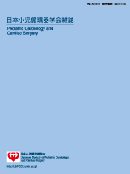Volume 30, Issue 1
Displaying 1-15 of 15 articles from this issue
- |<
- <
- 1
- >
- >|
Editorial
-
2014Volume 30Issue 1 Pages 1-2
Published: January 01, 2014
Released on J-STAGE: January 31, 2014
Download PDF (681K)
Reviews
-
2014Volume 30Issue 1 Pages 3-10
Published: January 01, 2014
Released on J-STAGE: January 31, 2014
Download PDF (966K) -
2014Volume 30Issue 1 Pages 11-21
Published: January 01, 2014
Released on J-STAGE: January 31, 2014
Download PDF (2015K)
Originals
-
2014Volume 30Issue 1 Pages 22-29
Published: January 01, 2014
Released on J-STAGE: January 31, 2014
Download PDF (1044K) -
2014Volume 30Issue 1 Pages 30-35
Published: January 01, 2014
Released on J-STAGE: January 31, 2014
Download PDF (1027K) -
2014Volume 30Issue 1 Pages 39-46
Published: January 01, 2014
Released on J-STAGE: January 31, 2014
Download PDF (999K) -
2014Volume 30Issue 1 Pages 49-56
Published: January 01, 2014
Released on J-STAGE: January 31, 2014
Download PDF (997K) -
2014Volume 30Issue 1 Pages 59-63
Published: January 01, 2014
Released on J-STAGE: January 31, 2014
Download PDF (1214K) -
2014Volume 30Issue 1 Pages 66-73
Published: January 01, 2014
Released on J-STAGE: January 31, 2014
Download PDF (1130K)
Case Reports
-
2014Volume 30Issue 1 Pages 74-78
Published: January 01, 2014
Released on J-STAGE: January 31, 2014
Download PDF (1725K) -
2014Volume 30Issue 1 Pages 79-84
Published: January 01, 2014
Released on J-STAGE: January 31, 2014
Download PDF (1234K)
Editorial Comments
-
2014Volume 30Issue 1 Pages 36-38
Published: January 01, 2014
Released on J-STAGE: January 31, 2014
Download PDF (814K) -
2014Volume 30Issue 1 Pages 47-48
Published: January 01, 2014
Released on J-STAGE: January 31, 2014
Download PDF (718K) -
2014Volume 30Issue 1 Pages 57-58
Published: January 01, 2014
Released on J-STAGE: January 31, 2014
Download PDF (748K) -
2014Volume 30Issue 1 Pages 64-65
Published: January 01, 2014
Released on J-STAGE: January 31, 2014
Download PDF (689K)
- |<
- <
- 1
- >
- >|
